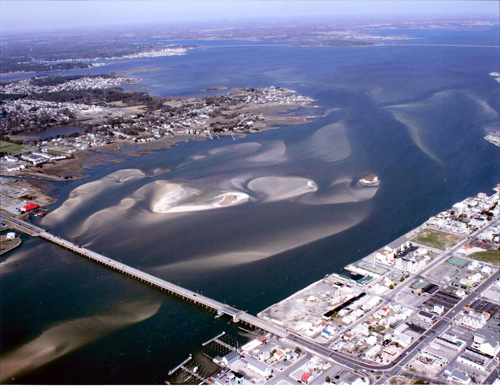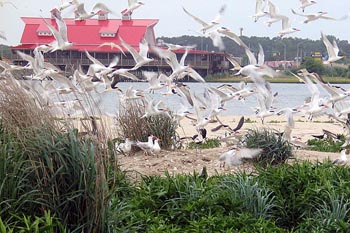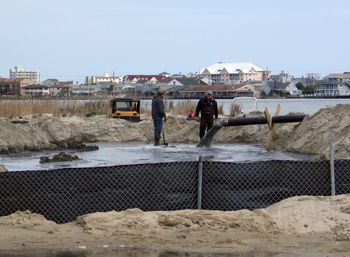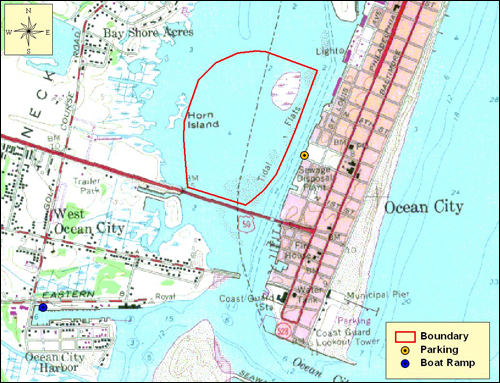Skimmer Island, Worcester County
 Ocean City locals and the Maryland birding community refer to Worcester County's most dynamic pieces of land as "Bird Island" or the "4th Street Flats." This complex of small islands and sand flats is officially named Skimmer Island. The main island is the primary nesting site for one of the state's most unusual birds, the Endangered black skimmer (Rhynchops niger). As it flies, this graceful bird's lower, knife-like bill cuts through the water's surface in a skimming fashion to catch small fish. This low, sandy island near the center of Maryland's busiest summer resort area is also a critical nesting site for the Endangered royal tern (Sterna maxima). This large, orange-billed tern engages in short, shallow dives to catch small crabs and fish. While Skimmer Island is only accessible by boat, visitors can see it easily with binoculars or a spotting scope from the sidewalk on the US 50 bridge, the west end of 1st Street, or from the fishing bulkhead that stretches from 2nd to 4th Streets in Ocean City. Skimmer Island (and a small buffer) is closed to public access from April 1st to September 15th to protect nesting bird colonies. Visitors can view these social birds from outside the marked buffer area in kayaks and shallow draft boats.
Ocean City locals and the Maryland birding community refer to Worcester County's most dynamic pieces of land as "Bird Island" or the "4th Street Flats." This complex of small islands and sand flats is officially named Skimmer Island. The main island is the primary nesting site for one of the state's most unusual birds, the Endangered black skimmer (Rhynchops niger). As it flies, this graceful bird's lower, knife-like bill cuts through the water's surface in a skimming fashion to catch small fish. This low, sandy island near the center of Maryland's busiest summer resort area is also a critical nesting site for the Endangered royal tern (Sterna maxima). This large, orange-billed tern engages in short, shallow dives to catch small crabs and fish. While Skimmer Island is only accessible by boat, visitors can see it easily with binoculars or a spotting scope from the sidewalk on the US 50 bridge, the west end of 1st Street, or from the fishing bulkhead that stretches from 2nd to 4th Streets in Ocean City. Skimmer Island (and a small buffer) is closed to public access from April 1st to September 15th to protect nesting bird colonies. Visitors can view these social birds from outside the marked buffer area in kayaks and shallow draft boats.

Skimmer Island did not exist prior to the formation of the Ocean City Inlet and its flood tidal shoal. In 1933, the Chesapeake-Potomac hurricane opened the inlet and a slow natural process began that eventually resulted in the formation of the island. In the late 1980s, the flood tidal shoal was substantial, but Skimmer Island still didn't exist as dry land above most high tides. By the mid-1990s, Skimmer Island had accreted enough sand to become the most important breeding site in Maryland for three species of colonial nesting waterbirds: black skimmer, and royal and common tern. To breed successfully these birds require predator-free barren sand beaches. The surrounding sand flats also provide key foraging habitat for a variety of shorebirds during their spring and fall migrations between their breeding grounds in the arctic and wintering habitats in the southern hemisphere. The beaches of Skimmer Island are also a critical spawning area for horseshoe crabs, which crawl up from the ocean depths during the full moon each May, to lay their tiny green eggs at the ocean's edges. Despite the name, these prehistoric relics are more closely related to spiders and scorpions than to crabs. This area is owned by the State and managed by the Maryland Wildlife and Heritage Service as part of Sinepuxent Bay WMA.
Selfish Herd: Safety in Numbers
 Colonial waterbirds, like skimmers and terns, are part of a diverse group of birds that gather together in dense colonies for security during the nesting season. This gathering behavior is referred to as the "selfish herd" because when a predator is faced with a large number of individuals to choose from, there is an individual safety that results from being a member of a large group. In Maryland, colonial waterbirds are a group of over 20 species that include pelicans, cormorants, gulls, terns, egrets, herons, and ibis. Breeding waterbird colonies are most likely to form at predator-free sites, usually remote islands.
Colonial waterbirds, like skimmers and terns, are part of a diverse group of birds that gather together in dense colonies for security during the nesting season. This gathering behavior is referred to as the "selfish herd" because when a predator is faced with a large number of individuals to choose from, there is an individual safety that results from being a member of a large group. In Maryland, colonial waterbirds are a group of over 20 species that include pelicans, cormorants, gulls, terns, egrets, herons, and ibis. Breeding waterbird colonies are most likely to form at predator-free sites, usually remote islands.
These particular islands are disappearing as sea levels rise and erode the small habitats waterbird colonies select as critical nesting sites.
Conservation Partnership
 Skimmer Island is constantly being reshaped by tidal currents and storms. In the late 1990s, Skimmer Island was over seven acres in size. Since then it has been rapidly losing ground, and by 2009 was just over two acres. In 2009, a joint effort to conserve Skimmer Island was started by the Ocean City Fishing Center, the Maryland Coastal Bays Program and the Maryland Department of Natural Resources. These organizations are working in a public-private partnership to use clean sand dredged from the Fishing Center's approach channel to nourish and restore the island. Each March, sand is pumped onto Skimmer Island to improve nesting habitat conditions for skimmers and terns. This "design with nature" management approach places sand on Skimmer Island to balance what is lost to erosive tidal currents. As sea levels rise, managers will continue to nourish the island with clean, dredged sand to maintain critical habitats. Skimmers, terns, horseshoe crabs and a myriad of other species will take advantage of the habitats that Skimmer Island and the tidal sand flats provide.
Skimmer Island is constantly being reshaped by tidal currents and storms. In the late 1990s, Skimmer Island was over seven acres in size. Since then it has been rapidly losing ground, and by 2009 was just over two acres. In 2009, a joint effort to conserve Skimmer Island was started by the Ocean City Fishing Center, the Maryland Coastal Bays Program and the Maryland Department of Natural Resources. These organizations are working in a public-private partnership to use clean sand dredged from the Fishing Center's approach channel to nourish and restore the island. Each March, sand is pumped onto Skimmer Island to improve nesting habitat conditions for skimmers and terns. This "design with nature" management approach places sand on Skimmer Island to balance what is lost to erosive tidal currents. As sea levels rise, managers will continue to nourish the island with clean, dredged sand to maintain critical habitats. Skimmers, terns, horseshoe crabs and a myriad of other species will take advantage of the habitats that Skimmer Island and the tidal sand flats provide.
To meet the requirements of Federal and State permits, the annual sand nourishment work is closely monitored and annual reports are produced. Annual reports for the preceding year are posted by 1 March of the following year.
Click here for a Print Version of this map.

Directions
From the Chesapeake Bay Bridge: Travel east 9 miles on US 50/301 and take the right turn to stay on US 50 at the split with US 301. Proceed nearly 95 miles to Ocean City. Turn left (north) onto MD 528 (Philadelphia Avenue), continue 3 blocks and turn left onto 3rd Street. Proceed 2 blocks, turn right, and park on the right. When not off-limits during the breeding season, Skimmer Island is accessible by boat. To avoid unnecessary disturbance of feeding and resting birds, landing on the island anytime is discouraged.


Driving directions and aerial views open with Google Maps. For the aerial view button, if an aerial view does not open by default, click on the Satellite icon in the upper right corner and Google Maps will switch to an aerial view of the Natural Area.

Acknowledgments
Scenic Ariel View of Skimmer Island, looking northeast of the US 50 bridge. Photo by: Andy Serrell
Wildlife Collage One: (left to right)
A black skimmer tends to its chick. Photo by: Dan Pancamo/Wikimedia Commons
Horseshoe crabs gather in great numbers at the water's edge on Skimmer Island to spawn and lay their eggs. The eggs will provide a valuable food source for many migrating shore-birds. Photo by: Richard Arnold
Red knots gather to feed on horseshoe crab eggs during their spring migration. Photo by: Gregory Breese/USFWS
A colony of royal terns and black skimmers on Skimmer Island. Photo by: Dave Brinker
Sand from the Ocean City Fishing Center is pumped onto the island. Photo by: Dave Brinker